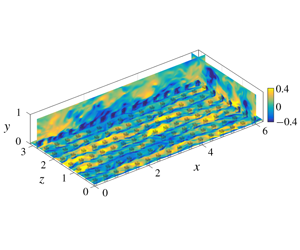Published online by Cambridge University Press: 06 February 2020

Turbulent flows within and over sparse canopies are investigated using direct numerical simulations at moderate friction Reynolds numbers  $Re_{\unicode[STIX]{x1D70F}}\approx 520$ and 1000. The height of the canopies studied is
$Re_{\unicode[STIX]{x1D70F}}\approx 520$ and 1000. The height of the canopies studied is  $h^{+}\approx 110{-}200$, which is typical of some engineering canopies but much lower than for most vegetation canopies. The analysis of the effect of Reynolds number in our simulations, however, suggests that the dynamics observed would be relevant for larger Reynolds numbers as well. In channel flows, the distribution of the total stress is linear with height. Over smooth walls, the total stress is the sum of the viscous and the Reynolds shear stresses, the ‘fluid stress’
$h^{+}\approx 110{-}200$, which is typical of some engineering canopies but much lower than for most vegetation canopies. The analysis of the effect of Reynolds number in our simulations, however, suggests that the dynamics observed would be relevant for larger Reynolds numbers as well. In channel flows, the distribution of the total stress is linear with height. Over smooth walls, the total stress is the sum of the viscous and the Reynolds shear stresses, the ‘fluid stress’  $\unicode[STIX]{x1D70F}_{f}$. In canopies, in turn, there is an additional contribution from the canopy drag, which can dominate within. Furthermore, the full Reynolds shear stress has contributions from the dispersive, element-induced flow and from the background turbulence, the part of the flow that remains once the element-induced flow is filtered out. For the present sparse canopies, we find that the ratio of the viscous stress and the background Reynolds shear stress to their sum,
$\unicode[STIX]{x1D70F}_{f}$. In canopies, in turn, there is an additional contribution from the canopy drag, which can dominate within. Furthermore, the full Reynolds shear stress has contributions from the dispersive, element-induced flow and from the background turbulence, the part of the flow that remains once the element-induced flow is filtered out. For the present sparse canopies, we find that the ratio of the viscous stress and the background Reynolds shear stress to their sum,  $\unicode[STIX]{x1D70F}_{f}$, is similar to that over smooth walls at each height, even within the canopy. From this, a height-dependent scaling based on
$\unicode[STIX]{x1D70F}_{f}$, is similar to that over smooth walls at each height, even within the canopy. From this, a height-dependent scaling based on  $\unicode[STIX]{x1D70F}_{f}$ is proposed. Using this scaling, the background turbulence within the canopy shows similarities with turbulence over smooth walls. This suggests that the background turbulence scales with
$\unicode[STIX]{x1D70F}_{f}$ is proposed. Using this scaling, the background turbulence within the canopy shows similarities with turbulence over smooth walls. This suggests that the background turbulence scales with  $\unicode[STIX]{x1D70F}_{f}$, rather than the conventional scaling based on the total stress. This effect is essentially captured when the canopy is substituted by a drag force that acts on the mean-velocity profile alone, aiming to produce the correct
$\unicode[STIX]{x1D70F}_{f}$, rather than the conventional scaling based on the total stress. This effect is essentially captured when the canopy is substituted by a drag force that acts on the mean-velocity profile alone, aiming to produce the correct  $\unicode[STIX]{x1D70F}_{f}$, without the discrete presence of the canopy elements acting directly on the fluctuations. The proposed mean-only forcing is shown to produce better estimates for the turbulent fluctuations compared to a conventional, homogeneous-drag model. These results suggest that a sparse canopy acts on the background turbulence primarily through the change it induces on the mean-velocity profile, which in turn sets the scale for turbulence, rather than through a direct interaction of the canopy elements with the fluctuations. The effect of the element-induced flow, however, requires the representation of the individual canopy elements.
$\unicode[STIX]{x1D70F}_{f}$, without the discrete presence of the canopy elements acting directly on the fluctuations. The proposed mean-only forcing is shown to produce better estimates for the turbulent fluctuations compared to a conventional, homogeneous-drag model. These results suggest that a sparse canopy acts on the background turbulence primarily through the change it induces on the mean-velocity profile, which in turn sets the scale for turbulence, rather than through a direct interaction of the canopy elements with the fluctuations. The effect of the element-induced flow, however, requires the representation of the individual canopy elements.